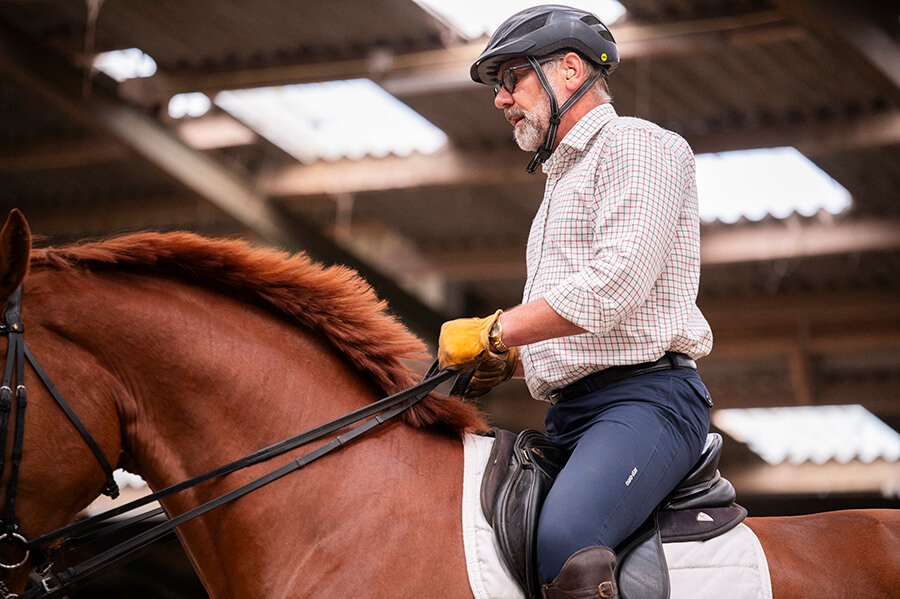
Christopher Hector sits in on a training session with Bert Rutten
(Photos – Sanne Wiering)
I first became aware of Bert when he chaired the Press Conference for the dressage horses at the KWPN stallion show in Den Bosch. This was no bureaucrat spouting the party line, but a subtle, questioning mind that was not afraid to ask, and answer, difficult questions. It was wonderful when he readily agreed to me bringing my little Aachen travel group to visit him, and watch him ride on the morning before we checked into our Aachen home, the Aquis Grana Hotel.
But I wasn’t quite prepared for all 190 cms of the first horse he rode, Orpheus a 5-year-old by Karolus Magnus out of a Canabis Z mare. I have spent the best part of a lifetime watching great riders in action, and the secret is, there is no secret at all, all those riders who really know what they are doing work in, in pretty much the same way, there tends to be lots, and lots, of walk at the beginning, melting into turns on the forehand, or hindquarters, shoulder in, half pass, travers, renvers, no fuss, no drama, no tension, just a slow motion twosome that gradually builds, moving into trot and canter.
Watching you work today, and it is so quietly logical, it makes me wonder where did the ‘spectacular’ fashion in dressage come from?
“It built up gradually over the years. It started small, and the quality of the horses got better. There are horses that are spectacular out of nature, and those are the better ones in the international arena. There are a lot of people who try to copy that, but you can’t copy that with a four or a five-year-old, if you want them off the floor you really have to ride them too much, too much in the hand and chase them…”
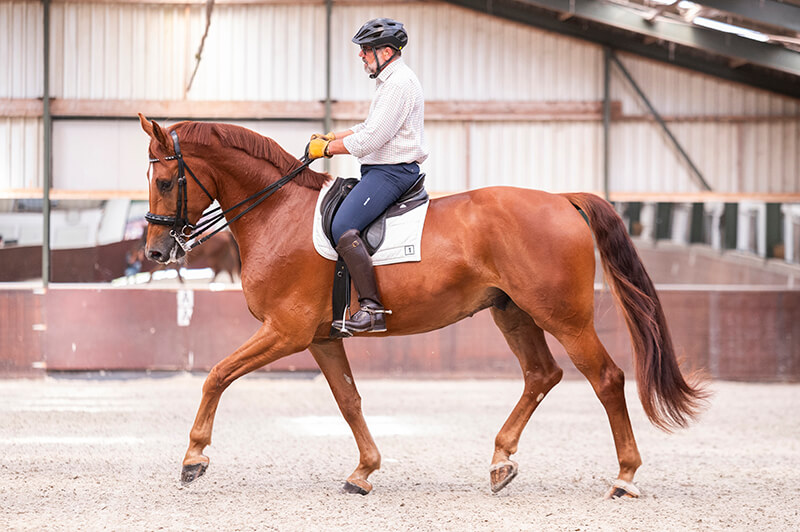
“The hard thing for a young horse, and the most important thing, is balance and rhythm, that they learn to stay with you, and you can bring your hand forward and they don’t take off with you. You put your leg on, and they are not scared of your leg, they have respect for your leg, but they shouldn’t be scared.”
You were saying, when you give the reins, that is when they listen to your leg…
“When they have space to go to in the front, and with time, these horses learn more and more to go into the contact, but that takes time, and I don’t think you should force that on a four or five-year-old.”
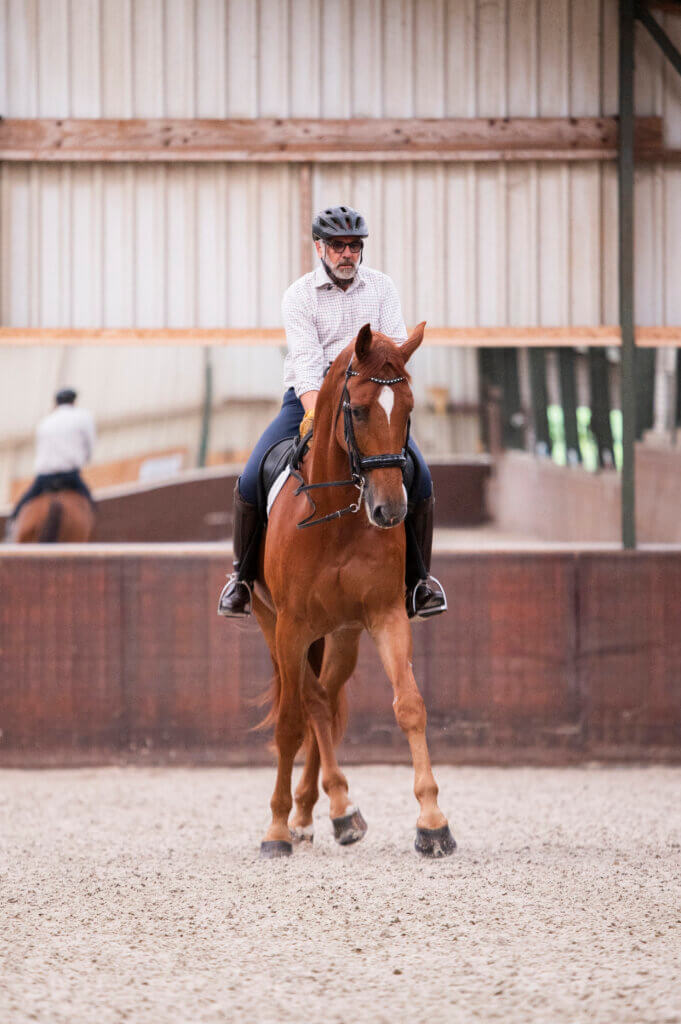
Your warm up was very quiet, a little lateral work in the walk…
“A little half pass, a little shoulder in, walk pirouettes. That’s basically the first movement I teach a young horse, the walk pirouette. I start with a pirouette around the forehand and build to a pirouette around the quarters, in the beginning they are big, but they just learn to accept the leg so I don’t have to hold the front to keep them smaller.”
“This one is only a five-year-old, but I trained that pirouette on a loose rein, and when I want contact, I can push him into the contact – he accepts that as well.”
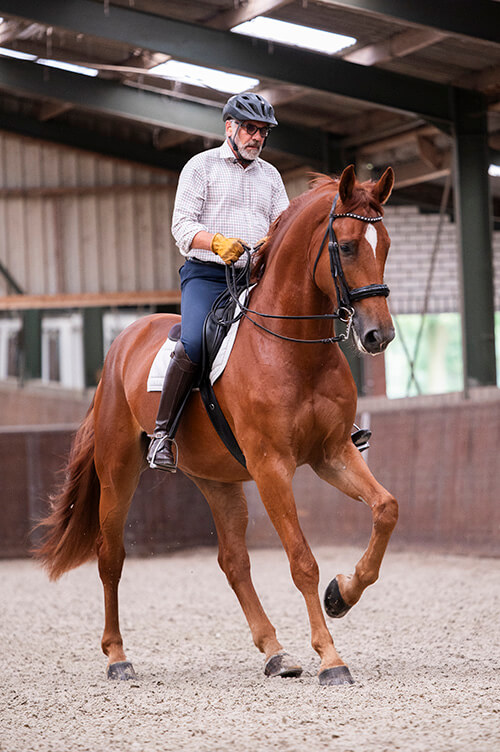
“But I have to be able to bring my hand forward and he stays where he is, that’s called self-carriage. Then when I push him, he must have the desire to follow the bit, forward, downwards, then I have contact, and contact is not determined by the weight you have in your hand, that’s a mistake a lot of riders make, they think contact is weight. Contact is that the horse has the desire to follow the bit at all times. That he wants to get longer in the frame at all times. When I ride a few steps of medium, I want to see the nose go forward, not that I crank him in, not what you see so often where in the extension the horse gets shorter in the neck. For me that should automatically be a five no matter how extravagant he is. That is my opinion.”
I think your opinion is shared by a few of us…
“In my opinion, that is where dressage has to go. In international competition we start to see this a little, they reward easy going, and loose in the rein.”
But now they seem to be going back again. When Carl and Charlotte came out at the Europeans, then at the London Games, it seemed to be going in the right direction, but now even Charlotte is riding with the short neck and the spur stuck in the horse’s side, it looks like we are back to hello Anky how are you…
“We will see where it goes, but I am really convinced that if dressage wants to survive, and we want to keep the social license to do our sport then everything has to look easy so that even the layman says ‘this looks nice’. You can see, rider and horse are one, they are a team.”
Who is going to train the judges to see that?
Listen hard and you will hear Bert chuckle…
“ That’s the big question!”
And that’s the problem because we don’t have judges who are horse people, or former
top competitors, they are rich ladies who can pay to fly around the world and who come up with the expected results…
“Those are your words not mine”
In the past we had head judges like Niggli and Lette, who provided some direction, now we don’t seem to have a direction or a leader…
“It looks like that, but that is the way it is and for now, I guess we have to live with it.”
But as you say, it endangers the future of equestrian sport…
“I also think riders and trainers should take the responsibility as well, and stop it, and maybe educate the judges as well – this is how we ride and we don’t go for those huge extravagant trots, and canters that come way off the floor. That sort of movement is not nice to watch.” And it can’t be nice sitting there…
“That I don’t know because I’ve never sat on a horse with a passage like that.”
The way you ride, it looks like fun…
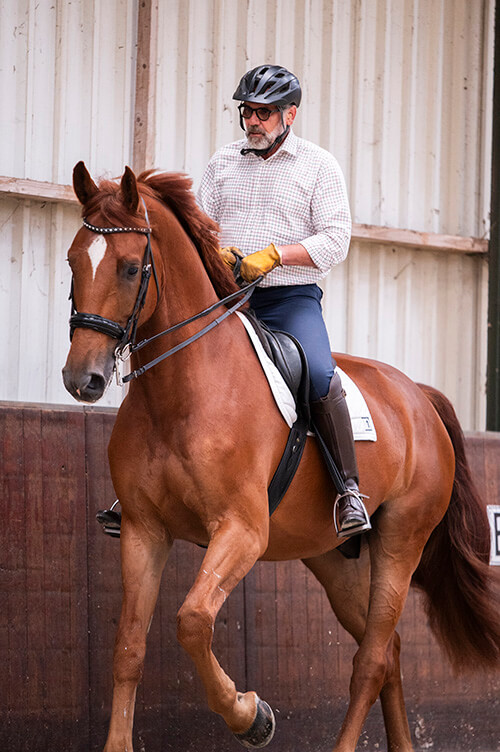
“It has to be fun. Of course you get the odd days where you have to put up the boundaries, every trainer will tell you that, but basically the horse has to trust you, basically tension works always against you. Ask yourself when your horse gets tense, or he doesn’t want to do what you are asking from him, why? Solve the why, don’t repeat the problem. That’s also what I see a lot with my students, half pass doesn’t work, and they keep half passing. What’s the problem, I say, He doesn’t bend. Why doesn’t he bend? Because he doesn’t carry himself. Work on self-carriage before you try to teach him how to half pass, because you are conditioning him not to carry himself when you keep repeating it when it is not working. You keep repeating the same mistake, so you are conditioning your horse to do it wrong.”
When you say it, it sounds so simple, but people find a way to make it very complicated…
“In principle it is not that complicated.”
I think George Morris got it right when he said, it’s simple but it is not easy…
“Yeah, there are no two horses the same, they all have a different character. It’s like children. Every parent, every trainer, makes mistakes, and regrets some things they have done in the past, but that is something you have to learn from, and be open about. Don’t try to pretend that everything is nice, we have to deal in our sport with people who are not so nice to horses, we have to admit that happens. There are also parents who are not too nice to their children.”
The perfect trainers exist only in their imagination and on their facebook pages…
Back to the horse you were riding today, if someone had told you that you were going to ride a horse a metre ninety tall, you would have said, no that’s too big…
“No, I never say no. I try to ride everything. But what I have always done, is that you have to accept the limitations of your horse. They get to Prix St Georges or even Grand Prix and they get 68, then they want to go for 70 when the limit of the horse is 68, then you have to be happy with 68. You ride a nice mistake free Grand Prix but the horse doesn’t have the huge movement they like to see, you have to accept that 68 is the limit. I think that is really important, not trying with more pressure to bring this horse to 70.”
It’s like a little while ago when you finished riding and said, that’s all there is today…
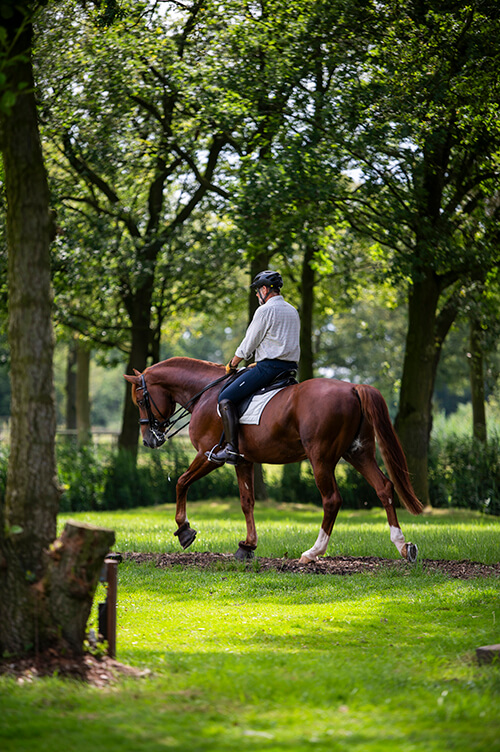
“You saw in the last five , ten minutes, I pushed him a little bit more, a little more forward, a little more contact, but then you feel ten minutes is enough, and then you stop, and you build it up over the years.”
How many times a week will you ride a young horse like this?
“Five times a week for the younger ones, the older ones when they come towards Grand Prix, six days a week. But also, not every day, an hour. I see a lot of people who ride by the clock, they think they have to ride an hour. When he does something right, you don’t have to repeat it over and over. You have to be confident enough in yourself to think, one line of ones is good, why should I repeat them? When my first pirouette is good, why turn ten?”
“A muscle that is tired, it doesn’t matter, an animal or a human, you can’t teach any more. If you ride a bike for ten kilometres, at the end even if someone hit you with a whip, you couldn’t go any faster, and with a horse it is no different.”
You say you have given up competition riding…
“It was not out of choice. One horse had an accident in the trailer coming back from Goodwood and I didn’t have a replacement. People started to ask me to do clinics, and I taught more, and never came back to competing again. I do a lot of teaching, I was teaching in Australia this morning, with a pixel camera. It works really well, like sitting in the corner, I can even see better because the camera is always close up, you really see the legs, the hands, you see everything.”
Into the arena came another horse, this time a stallion:
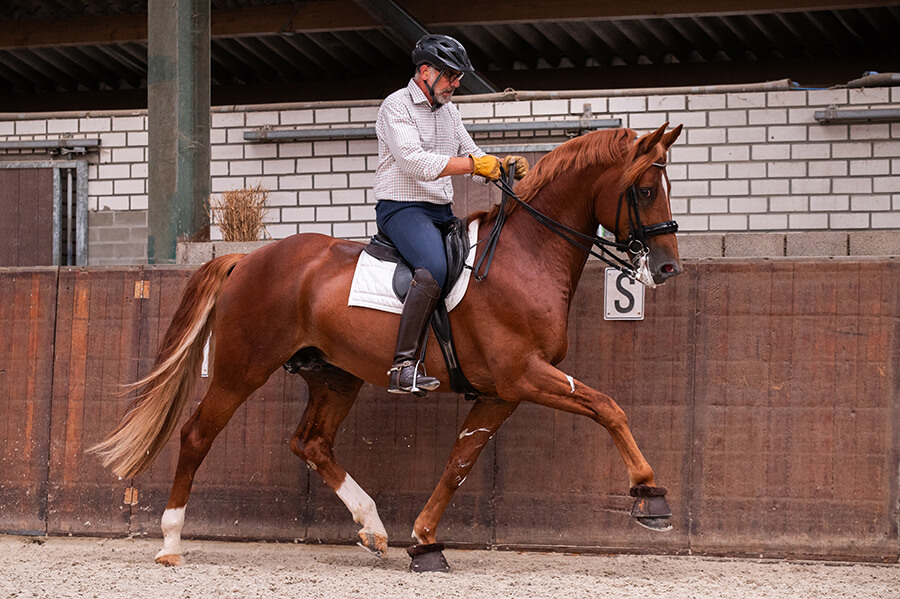
“This is Karolus magnus, the father of the taller one. He is by one of our stallions, Havanna out of Cosmo’s full-sister. Cosmo was raised at my stable and trained by me up until he was sold to family Rothenberger. Karolus is nine years old and he did his first Grand Prix this year. He is basically a Gelderlander and he went to the Gelderlander testing where they found he had WFFS, but I had five of his offspring, all okay. His father Havanna was positive as well.”
Gelderlander is not a fashionable word…
“No, but they make good horses. There are quite a few Gelderlanders that have been trained up to Grand Prix. His father was not Gelderlander but his mother was pure Gelderlander.”
It was time for us to join Bert for lunch, with my travelers buzzing with the over-load of information they had just absorbed…
Just when you are getting really cynical about the equestrian scene, along comes someone like Bert Rutten…
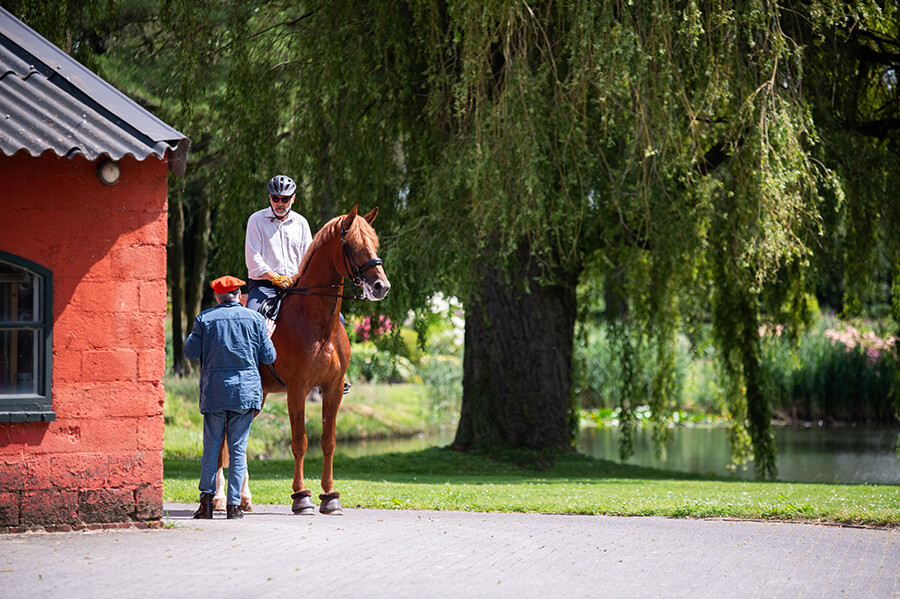


As an instructor i often feel like someone “calling in the dessert” as we in the Netherlands say. All those giant movers on the front lacking movement in the hind legs. So frustrating to see that well ridden horses are placed at the bottom of the field. Thank you for this interview. It made me smile and feel like on the right track for so many years and years to come.
Brilliant ! Thank you for reminding us!
When did this interview take place, please?
When was this interview made please?
Hi, I truly appreciate your interviews and stories about classical dressage training. Have you considered interviewing former FEI judge Gary Rockwell? I’ve audited several of his clinics here in the US and respect his classical perspectives and training methods.
Hi, I truly appreciate your interviews and stories about classical dressage training. Have you considered interviewing former FEI judge Gary Rockwell? I’ve audited several of his clinics here in the US and respect his classical perspectives and training methods.
july 2024